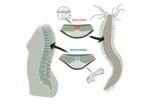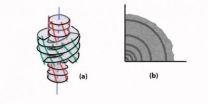(Press-News.org) The central mystery of quantum mechanics is that small chunks of matter sometimes seem to behave like particles, sometimes like waves. For most of the past century, the prevailing explanation of this conundrum has been what's called the "Copenhagen interpretation" — which holds that, in some sense, a single particle really is a wave, smeared out across the universe, that collapses into a determinate location only when observed.
But some founders of quantum physics — notably Louis de Broglie — championed an alternative interpretation, known as "pilot-wave theory," which posits that quantum particles are borne along on some type of wave. According to pilot-wave theory, the particles have definite trajectories, but because of the pilot wave's influence, they still exhibit wavelike statistics.
John Bush, a professor of applied mathematics at MIT, believes that pilot-wave theory deserves a second look. That's because Yves Couder, Emmanuel Fort, and colleagues at the University of Paris Diderot have recently discovered a macroscopic pilot-wave system whose statistical behavior, in certain circumstances, recalls that of quantum systems.
Couder and Fort's system consists of a bath of fluid vibrating at a rate just below the threshold at which waves would start to form on its surface. A droplet of the same fluid is released above the bath; where it strikes the surface, it causes waves to radiate outward. The droplet then begins moving across the bath, propelled by the very waves it creates.
"This system is undoubtedly quantitatively different from quantum mechanics," Bush says. "It's also qualitatively different: There are some features of quantum mechanics that we can't capture, some features of this system that we know aren't present in quantum mechanics. But are they philosophically distinct?"
Tracking trajectories
Bush believes that the Copenhagen interpretation sidesteps the technical challenge of calculating particles' trajectories by denying that they exist. "The key question is whether a real quantum dynamics, of the general form suggested by de Broglie and the walking drops, might underlie quantum statistics," he says. "While undoubtedly complex, it would replace the philosophical vagaries of quantum mechanics with a concrete dynamical theory."
Last year, Bush and one of his students — Jan Molacek, now at the Max Planck Institute for Dynamics and Self-Organization — did for their system what the quantum pioneers couldn't do for theirs: They derived an equation relating the dynamics of the pilot waves to the particles' trajectories.
In their work, Bush and Molacek had two advantages over the quantum pioneers, Bush says. First, in the fluidic system, both the bouncing droplet and its guiding wave are plainly visible. If the droplet passes through a slit in a barrier — as it does in the re-creation of a canonical quantum experiment — the researchers can accurately determine its location. The only way to perform a measurement on an atomic-scale particle is to strike it with another particle, which changes its velocity.
The second advantage is the relatively recent development of chaos theory. Pioneered by MIT's Edward Lorenz in the 1960s, chaos theory holds that many macroscopic physical systems are so sensitive to initial conditions that, even though they can be described by a deterministic theory, they evolve in unpredictable ways. A weather-system model, for instance, might yield entirely different results if the wind speed at a particular location at a particular time is 10.01 mph or 10.02 mph.
The fluidic pilot-wave system is also chaotic. It's impossible to measure a bouncing droplet's position accurately enough to predict its trajectory very far into the future. But in a recent series of papers, Bush, MIT professor of applied mathematics Ruben Rosales, and graduate students Anand Oza and Dan Harris applied their pilot-wave theory to show how chaotic pilot-wave dynamics leads to the quantumlike statistics observed in their experiments.
What's real?
In a review article appearing in the Annual Review of Fluid Mechanics, Bush explores the connection between Couder's fluidic system and the quantum pilot-wave theories proposed by de Broglie and others.
The Copenhagen interpretation is essentially the assertion that in the quantum realm, there is no description deeper than the statistical one. When a measurement is made on a quantum particle, and the wave form collapses, the determinate state that the particle assumes is totally random. According to the Copenhagen interpretation, the statistics don't just describe the reality; they are the reality.
But despite the ascendancy of the Copenhagen interpretation, the intuition that physical objects, no matter how small, can be in only one location at a time has been difficult for physicists to shake. Albert Einstein, who famously doubted that God plays dice with the universe, worked for a time on what he called a "ghost wave" theory of quantum mechanics, thought to be an elaboration of de Broglie's theory. In his 1976 Nobel Prize lecture, Murray Gell-Mann declared that Niels Bohr, the chief exponent of the Copenhagen interpretation, "brainwashed an entire generation of physicists into believing that the problem had been solved." John Bell, the Irish physicist whose famous theorem is often mistakenly taken to repudiate all "hidden-variable" accounts of quantum mechanics, was, in fact, himself a proponent of pilot-wave theory. "It is a great mystery to me that it was so soundly ignored," he said.
Then there's David Griffiths, a physicist whose "Introduction to Quantum Mechanics" is standard in the field. In that book's afterword, Griffiths says that the Copenhagen interpretation "has stood the test of time and emerged unscathed from every experimental challenge." Nonetheless, he concludes, "It is entirely possible that future generations will look back, from the vantage point of a more sophisticated theory, and wonder how we could have been so gullible."
INFORMATION:
Fluid mechanics suggests alternative to quantum orthodoxy
2014-09-12
ELSE PRESS RELEASES FROM THIS DATE:
Corn spots: Study finds important genes in defense response
2014-09-12
When corn plants come under attack from a pathogen, they sometimes respond by killing their own cells near the site of the attack, committing "cell suicide" to thwart further damage from the attacker. This cell sacrifice can cause very small, often microscopic, spots or lesions on the plant.
But up until now it's been difficult to understand how the plant regulates this "spotty" defense mechanism because the response is so quick and localized.
Researchers at North Carolina State University have identified a number of candidate genes and cellular processes that appear ...
Experts call for massive global response to tackle Ebola
2014-09-12
AUDIO:
Professor Peter Piot, Director of the London School of Hygiene & Tropical Medicine, explains how he co-discovered the Ebola virus in 1976, and gives his views on the current Ebola...
Click here for more information.
The current Ebola outbreak now requires a "rapid response at a massive global scale", according to experts at the London School of Hygiene & Tropical Medicine.
Writing an editorial in Science, Professor Peter Piot, co-discoverer of the virus, says that the ...
Stanford-led study assesses the environmental costs and benefits of fracking
2014-09-12
A strange thing happened on the way to dealing with climate change: Advances in hydraulic fracturing put trillions of dollars' worth of previously unreachable oil and natural gas within humanity's grasp.
The environmental costs – and benefits – from "fracking," which requires blasting huge amounts of water, sand and chemicals deep into underground rock formations, are the subject of new research that synthesizes 165 academic studies and government databases. The survey covers not only greenhouse gas impacts but also fracking's influence on local air pollution, earthquakes ...
Piglet health
2014-09-12
Porcine neonatal coccidiosis is a serious parasitic infection of young piglets that severely damages the intestinal mucosa, leading to diarrhoea and reduced nutritional intake. As the infection reduces animal growth, and because secondary infections can result in increased mortality, the disease is responsible for substantial economic losses at affected pig farms.
"The developing immune system of neonatal piglets is not yet mature enough to deal with the parasites. For this reason, an infection shortly after birth results in weakened intestinal tissue with appropriate ...
Moving silicon atoms in graphene with atomic precision
2014-09-12
Richard Feynman famously posed the question in 1959: is it possible to see and manipulate individual atoms in materials? For a time his vision seemed more science fiction than science, but starting with groundbreaking experiments in the late 1980s and more recent developments in electron microscopy instrumentation it has become scientific reality. However, damage caused by the electron beam is often an issue in such experiments.
The present study focused on single-layer graphene with silicon atoms embedded into the lattice, previously created and studied by the collaborators ...
Cutting the cloud computing carbon cost
2014-09-12
Cloud computing involves displacing data storage and processing from the user's computer on to remote servers. It can provide users with more storage space and computing power that they can then access from anywhere in the world rather than having to connect to a single desktop or other computer with its finite resources. However, some observers have raised concerns about the increased energy demands of sustaining distributed servers and having them up and running continuously, where an individual user's laptop might be shut down when it is not in use or the resources utilization ...
From worm muscle to spinal discs
2014-09-12
Thoughts of the family tree may not be uppermost in the mind of a person suffering from a slipped disc, but those spinal discs provide a window into our evolutionary past. They are remnants of the first vertebrate skeleton, whose origins now appear to be older than had been assumed. Scientists at the European Molecular Biology Laboratory (EMBL) in Heidelberg, Germany, have found that, unexpectedly, this skeleton most likely evolved from a muscle. The study, carried out in collaboration with researchers at the Howard Hughes Medical Institute in Janelia Farm, USA, is published ...
New family of materials for energy-efficient information storage and processing
2014-09-12
Switching the polarity of a magnet using an electric field (magnetoelectric memory [MEM] effect), can be a working principle of the next-generation technology for information processing and storage. Multiferroic materials are promising candidates for the MEM effect, due to the coexistence of electric and magnetic orders. On the other hand, the coexistence of spontaneous electric and magnetic polarizations is rare in known materials, which hinders the application potential of the MEM effect. This article briefly reviews a new family of multiferroic materials—hexagonal rare ...
Conjecture on the lateral growth of Type I collagen fibrils
2014-09-12
Whatever the origin and condition of extraction of type I collagen fibrils, in vitro as well as in vivo, the radii of their circular circular cross sections stay distributed in a range going from 50 to 100 nm for the most part of them. Jean Charvolin and Jean-Francois Sadoc from the solid state physique laboratory at the Paris-Sud University propose therefore that, once the growth of the fibrils has been triggered by external biological factors, their lateral size be limited by internal physical stresses generated during the growth. Their conjecture is based ...
Extension of standard model by knot algebra
2014-09-12
This paper makes a connection between the quantum group SLq(2), which described knots, and the elementary particles of the standard model. The elements of the fundamental (j = 1/2) representation of SLq(2) are interpreted as creation operators for preons. The preons interact through a preonic vector field defined by elements of the adjoint (j = 1) representation. The leptons and quarks then appear (as required by the electroweak data) as elements of the j = 3/2 representation. Unexpectedly the electroweak quantum numbers of the so defined preons, leptons, and quarks agree ...





